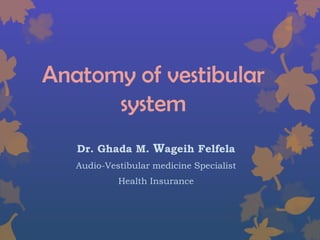
Anatomy of Vestibular System
- 1. Anatomy of vestibular system Dr. Ghada M. Wageih Felfela Audio-Vestibular medicine Specialist Health Insurance
- 2. Balance of our body during static or dynamic positions is maintained by: 1. Vestibular apparatus (inner ear) [Fastest system]. 2. Vision (Eye) 3. Somatosensory/ proprioceptive system
- 3. Vestibular function contributes to: - Perception of Self-motion - Head position in relation to motion - Stabilizing body position to avoid falling - Spatial orientation relative to gravity - posture correction - Adaptation to new balance tasks & - Central Compensation after vestibular diseases.
- 4. Types of movement: 1. Translational (Linear) 2. Rotational
- 6. Vestibular system is formed of bony & membranous labyrinth with 5 sensory end organs: 1. 3 crista ampularis in 3 SCC → for angular velocity. 2. 2 otolith organs: Utricle & Saccule → for linear acceleration
- 7. Fluid Dynamics: - Perilymph is a filtrate of CSF and from blood vessels in the ear. - Endolymph is from marginal cells of the stria vascularis of the cochlea and the dark cells of the vestibular labyrinth. Endolymph Circulation: a) The longitudinal endolymph flows toward endolymphatic sac, where it is resorbed. b) The radial theory a local transverse and active diffusion process between endolymph and perilymph. c) The dynamic theory.
- 9. CELLULAR MORPHOLOGY OF VESTIBULAR SENSORY EPITHELIUM: - The sensory epithelium is composed of: o Hair cells, • Type I cells: Flask-shaped cells”, enclosed by a nerve calyx → Phasic receptors (fire when move). • Type II cells: Cylindrical body → Tonic receptors (fire all the time). o Supporting cells, • Extend from the basement membrane to the apical surface, with basal nuclei just above BM and below the hair cells. • Supporting cells can differentiate into new hair cells following destruction of the sensory epithelium as after acoustic trauma. o Afferent nerve fibers o Efferent nerve fibers
- 11. o TIP-LINKS: o RIBBON SYNAPSE: o Relationship between the Direction of Force and Hair Cell Activation: - The adequate stimulus for hair cell activation is a force acting parallel to the top of the cell, resulting in bending of the hairs. - Deflection of the hairs toward the kinocilium causes depolarization. - While, bending in the opposite direction produces the reverse effect (hyperpolarization).
- 12. Semi Circular Canals • Each canal forms two-thirds of a circle. • provide sensory input about angular head velocity. • Head motion frequencies (0.5–7 Hz). • each canal is maximally sensitive to rotations that lie in the plane of that canal. o Lateral canal inclined to 30 degrees sensitive to rotations about a vertical axis. o Superior/posterior canals 45° off of sagittal plane
- 13. END ORGAN ANATOMY: Ampulla, contains the o Neuroepithelium (crista ampullaris), o Cupula, gelatinous mass consists of mucopolysaccharides within a keratin meshwork, extends from the surface of the cristae to the roof and lateral walls of the membranous labyrinth form a fluid-tight partition, dividing the interior of the ampulla into two approximately equal parts. o Supporting cells, o Connective tissue, blood vessels, and nerve fibers.
- 14. • In horizontal SCC cristae, the kinocilia are located on the side of the hair cell, closest to the utricle. • In vertical SCC cristae, the kinocilia are located on the side of the hair cell furthest from the utricle, the canalicular side. • The ampullae of HSCC and ASCC lie close together, just above the oval window, but the ampulla of the posterior canal opens on the opposite side of the vestibule
- 16. SCC & Detection of angular acceleration: dynamic equilibrium: A. Each afferent neuron has a baseline firing rate “Resting potential”:……. Morphological polarization….. coplanar arrangement….. B. “Push-Pull organization”:………. A. Angular Velocity: 1. Within first few seconds of rotation, endolymph lags behind and rotates within SCC in a direction opposite that of the head. 2. After about 5 to 20 seconds of constant speed, the cupula slowly returns to its resting position by its own elastic recoil. 3. When the rotation suddenly stops - the cupula bends in the opposite direction, causing the hair cell to stop discharging entirely.
- 18. Ewald’s laws: 1) the eye and head movements always occurred in the plane of the canal being stimulated and in the direction of endolymph flow 2) ampullopetal endolymph flow in the horizontal canal caused a greater response and ampullofugal endolymph flow in the vertical canals caused a greater response than did ampullopetal endolymph flow.
- 20. Macula: • Definition: is a thickened ectodermal elliptical patch, elongated “J- shaped”, in which the hair cells of each organ is localized, is 2 mm in diameter • In the utricle the macula projects from the anterior wall on the floor of that tubular sac, contains about 30,000 hair cells. • In the saccule the macula is in the vertical plane and directly overlies the bone of the inner wall of the vestibule. & contains some 16,000.
- 21. Each macula consists of neuroepithelium: - supporting cells and - sensory cells, - a basement membrane, - nerve fibres and nerve endings, - underlying connective tissue……………… - otolithic membrane, that covers the entire sensory macula. - Otoconia (“ear dust”) or “statoconia”: • fine, dense particles • rhombohedral crystals (0.5-20 μm long) • Consisting of calcium carbonate • embedded within and lying on the otolithic membrane. • SG is almost 3 times that of the membrane and the endolymph— and thus add considerable mass to it.
- 22. Abnormal or reduced otoconia have been produced in humans by: Aminoglycosides, phenytoin, carbonic anhydrase inhibitors, prostaglandins, and ethacrynic acid. Aging also lead to loss of otoconia. Alteration in endolymphatic ion concentration may be the cause of both hair cell and otoconial degeneration.
- 23. • In the saccule and utricle, the striola divides the hair cells into populations with opposing hair bundle polarities.
- 24. MECHANISM OF STIMULATION • Detection of linear acceleration: static equilibrium & linear acceleration
